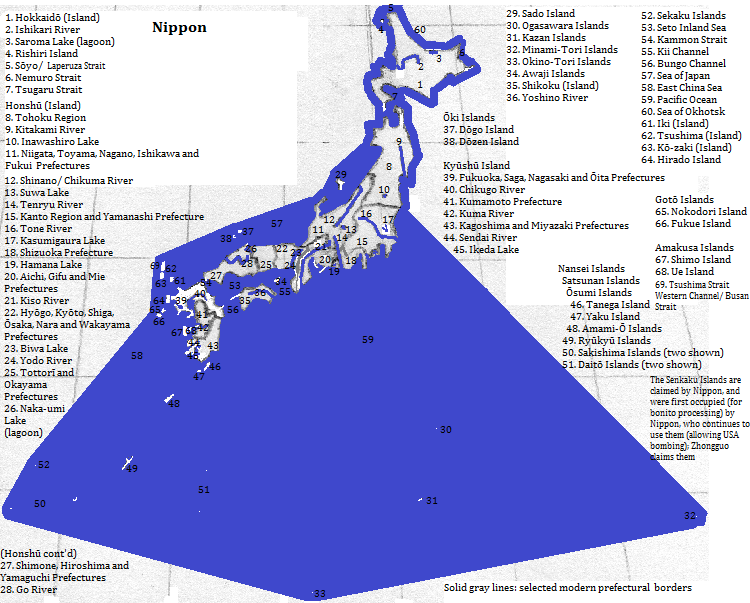
| To Duval Family Home Page | Asia |
| To Chris Home Page | |
| To Earth (Geography Home Page) |
⽇夲 (Nippon
The UNESCO World Heritage Sites honoring nature are: Shirakami-Sanchi (Akita and Aomori Prefectures); Shiretoko (Hokkaidō); Yakushima (Yaku Island) and Mount Fuji (near to Gotenba and Fujinomiya in Shizuoka Prefecture and Fujiyoshida in Yamanashi Prefecture). Tourists also visit Jigokudani Monkey Park in Yamanouchi (Nagano Prefecture).
Almost everyone speaks Japanese and almost everyone considers himself a Buddhist, a Shintoist--the indiginous religion--or both, though observance is slight for many. There are numerous eclectic 'new religions' which--while they regard themselves as Buddhist or Shinto--incorporate elements from Confuscianism, Taoism and Christianity, and are not deemed true Buddhists or Shintoists by those adhering to the old religions; perhaps one in seven fall in this category.
For a list of cities, see table of Japanese cities.
About six million live on Hokkaidō, about 100 million on Honshū, about four million on Kyūshū, and more than a million in the Nanseis.
The UNESCO World Heritage Sites honoring culture are: the Buddhist Monuments in the Horyu-ji Area in Ikaruga, Himeji-jo in Himeji, the Historic Monuments of Ancient Kyoto,

About 13,000 years ago there was a change in material culture and by the end of this period, abokut 300 BCE, the ancesters of the Japanese were present. When they arrived and from where is unknown. Between 300 BCE and 300 BCE large numbers of Korean and Chinese immigrants arrived but by 900 they had assimulated and intermarried as Japanese. Shintoism is ancient and was supplemented by Buddhism starting in the sixth century.
There is one exception to this linguistic homogeneity: the Ainu. These hunter-gatherers lived in northern Honshu up until about 1000 years ago

picture taken from the train between Nara Prefecture and Iga in Mie Prefecture
northwest
northeast and east
south
west from the Nansei Islands
west from the main islands
northwest from Tsushima, the westernmost island
1. Less formally pronounced Nihon, using a more modern pronounciation of the second character. The characters represent sun-origin and so are often translated as Land of the Rising Sun. It is called Japan in English.
2. Or Nansei Island Group. The most important sub-group is the Ryūkyū (Ryuku in English), and the entire chain is sometimes called this. The Nansei chain is sometimes called by the largest of the Ryūkyūs, Okinawa.
3. In Kyōtō, Uji and Otsu. Himeji-do (castle) in Himeji and Kiyomizu-dera in Kyōtō are also top ten tourist attractions according to http://www.touropia.com/tourist-attractions-in-japan/, accessed 3/26/2014.
4. Todai-ji (temple) and Rokuon-ji (the temple of the Golden Pavillion) are top ten tourist attractions according to http://www.touropia.com/tourist-attractions-in-japan/, accessed 3/26/2014.
5. In Naha, Nakijin (Okinawa Island), Yomitan, Uruma, Nagagusuku (Okinawa Island) and Nanjō.
6. Top ten tourist attractions according to http://www.touropia.com/tourist-attractions-in-japan/, accessed 3/26/2014.
7. In rural Gifu Prefecture and in Nanto.
8. At Yoshino, Katsuragi and Kudoyama in the Keihanshin MMA, Tenkawa (rural Nara Prefecture), Tanaba, Shingū, Nachikatsura (Wakayama Prefecture), and Kōya (Wakayama Prefecture); and in the trails connecting these places.
9. Until sometime in the Nara Period, 701-1185 CE.